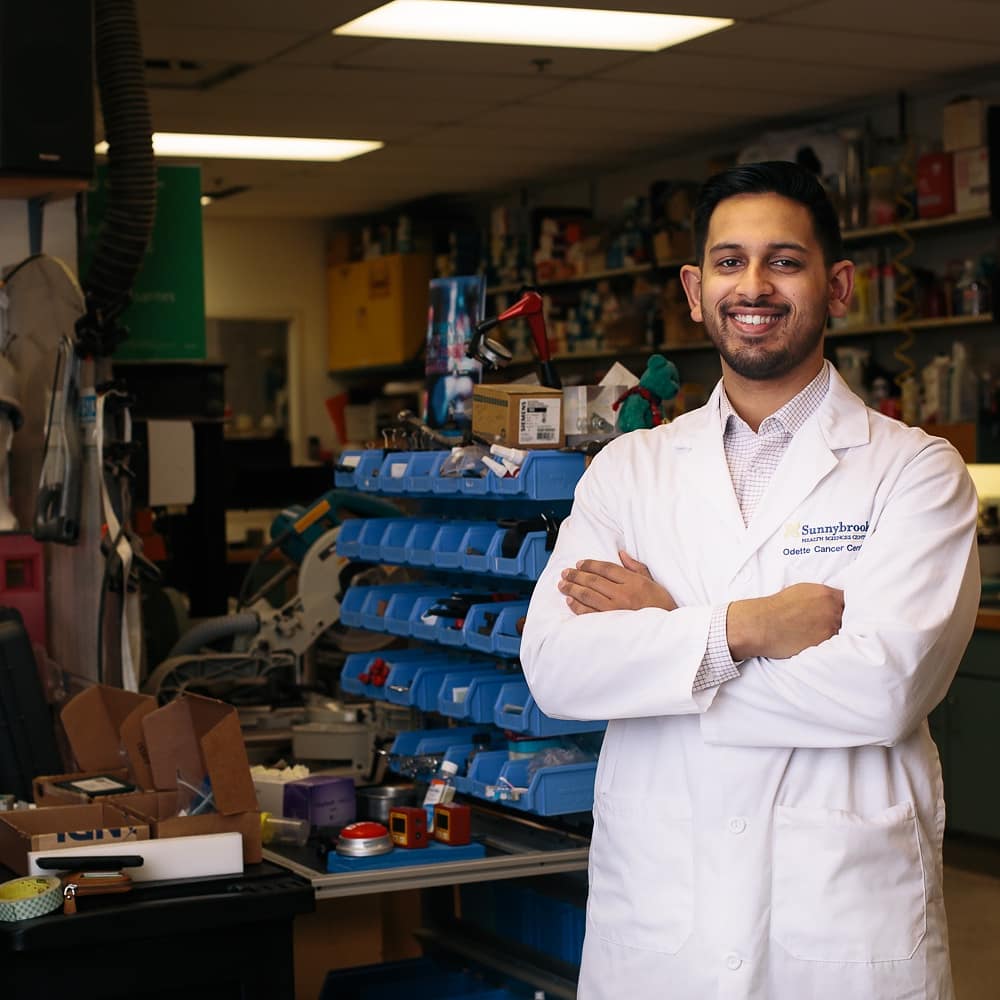Humza Nusrat: Carving out a career path at Sunnybrook Health Sciences Centre

Humza Nusrat, Biomedical Physics '19
The medical physics job market is notoriously tight in Canada, but strategic planning proved its worth for Humza Nusrat (Biomedical Physics ’19). Years ago, he’d discerned that the magnetic resonance guided linear accelerator (MR-Linac) would be the future of cancer treatment. Toronto’s Sunnybrook Hospital was the first in Canada to have one — and Nusrat wanted to be there.
Over the years, he built his record at the hospital — from clinical shadowing, to PhD research, to medical physics residency. Now, Nusrat’s on board as a working clinician-scientist. We talked to the alumnus about his career path, return to Ryerson as an adjunct professor and real-world tips for students.
What’s it like working at one of Canada’s premier academic hospitals?
Sunnybrook is a great place for medical physicists. It’s really strong clinically, and the research institute is literally just down the hall. So, half of my time is spent in the clinic — checking patient charts, planning treatment, consulting on brachytherapy, etc. — but the rest is research.
I actually began my PhD work at the hospital’s Odette Cancer Centre under Dr. Arman Sarfehnia (external link) , and co-supervised by Dr. Carl Kumaradas at Ryerson. I was developing novel detectors that can measure radiation quality, or their ability to cause cell death. That leads into some of my current research developing a real-time patient dosimetry device for MRI-guided radiotherapy. My undergraduate student at Ryerson is now working on computer simulations, and we’ll check those against clinical results before building a prototype.
Congratulations on receiving your first research grant! What’s the project?
The grant is from the Canadian Nuclear Safety Commission (CNSC) and the Canadian Organization of Medical Physicists (COMP) to develop a virtual reality (VR) simulator for training radiation staff. Sunnybrook is one of the biggest cancer centres in North America with 13 linear accelerators — very expensive machines that can be very dangerous. We constantly need to train staff on using them safely. I knew VR could help and am developing a VR-based training simulator to familiarize people with the machines before they begin in-person training. So, they come in “with their feet wet”, which will relieve some of the time and burden spent training.
"Our field is rapidly changing, and being at the forefront, always driving to improve — that really excites me."
You were very strategic with career planning. What did that involve for medical physics?
Here’s a big tip: where you do your residency is very important. I thought about the technologies that interested me and decided from there where to apply. I could see that the MR-Linac was ground-breaking and that soon, every centre would have one. Sunnybrook was one of the only hospitals around the world to have one at the time, so that’s where I wanted to train. Other friends were interested in proton therapy, so they went to hospitals in the U.S., for example. Apply strategically to places that already specialize in your interest area.
You began networking and professional activities early on. Why?
Ryerson taught me the importance of networking. I joined groups, networking events and career development programs. Whatever area I was interested in professionally, I also reached out to people on LinkedIn who were already ten years ahead, and I learned how they got there. I also asked my supervisors if they knew people at certain centres that I could chat with.
I also wasn’t stuck on staying in Toronto. So, I joined professional associations not only in Canada but America too, such as the AAPM (American Association of Physicists in Medicine). I got involved in their student groups and committees and eventually chaired some. People got to know me, and I made lots of new friends in the medical physics community. Professional activity can show employers that you’re not just looking to do the minimum, but are ambitious about leading change. Be conscious of taking steps early on to set you up for success.
"Many don't realize it until later on, but new opportunities often come directly from networking. I learned that at Ryerson."
You also enjoyed TA work. How did that impact you?
Not everyone enjoys being a teaching assistant, but for me, it was one of the best parts of grad school. I picked up a new skill set and loved teaching, mentoring and sharing in students’ successes. TA work pushed me in the direction of teaching. Now, as adjunct faculty, I really enjoy supervising my undergraduate student and working together on research. I’m also advocating to increase artificial intelligence, automation and virtual reality in the medical physics didactic curriculum.
How did RU equip you for success?
Ryerson was the launchpad that propelled me professionally. I got exposed to so much and grew a lot — from who I was at the start to who I was when I left. While applying for residency, I also got offers for industry and postdoctoral positions. The program had exposed me to all of those settings, so I was ready for any of them. The CAMPEP program was also fantastic. The department did an amazing job making sure students understood core materials, were familiar with hospital settings through clinical shadowing, and were ready for residency.
Zone learning was also unique. I joined the Science Discovery Zone during my PhD and learned entrepreneurial thinking — not just in terms of commercializing, but to be cognizant of making an impact. That's very RU centric, and it continues to influence my research directions.
What are your future goals?
I want to establish myself clinically and eventually become a leader in my field. I want to make things better for patients, with a key focus on developing new tech for radiation use — not just for cancer, but even other potential applications. Our field is rapidly changing, and being at the forefront, always driving to improve really excites me.